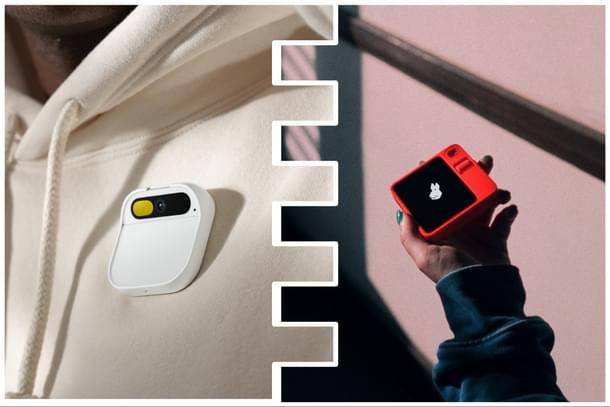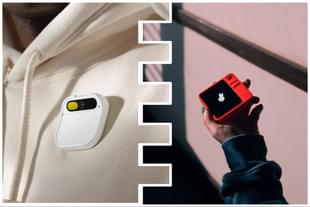Technology
Reviews Are In — New-Age AI Devices Humane Ai Pin And Rabbit r1 Are Flopping
Karan Kamble
May 10, 2024, 06:22 PM | Updated Aug 06, 2024, 12:35 PM IST
Save & read from anywhere!
Bookmark stories for easy access on any device or the Swarajya app.


An entirely new generation of devices centred around artificial intelligence (AI) have cropped up over the last year. They have promised to give our eyes and fingers — and even our minds — a much-needed break after smartphone makers have worked overtime to keep us glued to the mobile screen.
The most buzzing of these ‘AI in a box’ devices are the Humane Ai Pin and the Rabbit r1, both of which represent a departure from the smartphone paradigm. After the initial excitement around the idea, the devices have started reaching homes, and the early reviews are streaming in.
In quite an anti-climax, the word on the street isn’t good for either of those devices.
Marques Brownlee, a well-known tech YouTuber with close to 19 million subscribers and billions of video views, reviewed both the Ai Pin and the r1 a couple of weeks apart. He found one device to be “the worst product I’ve ever reviewed” and the other “barely reviewable”.
Pin And The Bunny
The Ai Pin is a standalone, wearable device and software platform powered by AI. It is worn on your outfit around the chest area, so that it can tag along wherever you go and learn about you and your surroundings constantly, depending on your interactions with it. The way to engage with it is through touch, voice, gesture, or the screenless screen of your palm by way of the laser ink display.
Another ‘AI in a box’, though wearing an entirely different look, is the Rabbit r1. It’s a good-looking, bright-orange gadget dressed in retro for a nostalgic hit. It can ‘speak’ with you in natural language, a bit like a talking ChatGPT. But, notably, it can also get things done for you based on your interactions with the built-in AI model, dubbed the “large action model” (LAM).
The promise of the r1 is that you simply tell it what needs to be done, such as book a ride home, and it follows through, even if the task involves multiple apps and actions.
The Review
First, the Ai Pin. Brownlee found it to be “bad at almost everything it does, basically all the time” after using it for about a week.
In his experience, the device is “often slow” and “often wrong” when you ask it to answer questions. It also features a poor and unpredictable battery backup. “You have to constantly babysit the battery and swap out boosters and charge this thing and keep it charged multiple times a day.”
Further, the Pin cannot do simple things like set a timer or an alarm. And because there are no apps, “it just will not do any of that stuff that I just do on my phone.”
The Pin’s biggest problem, according to Brownlee, is that it is not a smartphone replacement. “Everything that this Pin does, a modern smartphone does better and faster and easier and higher quality and just better in every way.”
“Nobody should buy this device right now,” he said.
There was some curiosity about what Brownlee’s verdict would be for the r1, since even Jesse Lyu, the founder and chief executive officer of Rabbit, said at an event, “I don’t think MKBHD (referring to Brownlee) will say this is the worst device he ever reviewed so far.”
The vlogger found the r1 to be “consistently quicker” than the Ai Pin in answering questions, but that’s about it. “This thing is also bad at a lot of stuff,” he said.
The device’s battery backup is awful, like the Ai Pin, and again, like the wearable device, has some basic features missing, like setting a timer or an alarm, sending an email, or a calendar. “A lot of things that I would want an assistant to do, not here,” Brownlee said. It also confidently answers questions wrong.
The r1’s hardware features, not present on the Pin — a screen, a scroll wheel, a button — apparently present some hassle in using the device. For instance, the scroll wheel is not sensitive enough. So, the thumb needs to get busier than expected to run up and down a menu of options, like the settings. In some instances, you need to use both your hands to use the device, such as increasing or decreasing the brightness.
Priced at $200, the r1 is significantly cheaper than the Pin with its $700 price tag and the necessary $24 monthly subscription. But while it is cheap, it apparently also looks cheap.
The r1’s true differentiating factor is probably the built-in action model that is supposed to go a step further than large language models (LLMs) and execute tasks for you. However, there’s not much that can be done with LAM as yet. There are currently only four in-built services that the r1 is able to connect to — Spotify (music), Uber (rideshare), DoorDash (food delivery), and Midjourney (AI image generation). But even with these four apps alone, users have reported issues.
The “teach mode” — the ability to train the r1 to execute a particular task by taking it through the various steps — is another great feature, but unfortunately, even that is still in the works.
“These AI-based products are at the apex of this horrible trend where the thing you get at the beginning is borderline non-functional compared to all the promises and all the features and all the things that it’s supposed to maybe someday be,” the YouTuber said, adding that “you still pay full price at the beginning, which is what makes this so crazy.”
Other Reviews Tell Same Story
Various aspects of Brownlee’s criticism are echoed across multiple reviews of these two devices.
In his in-depth review of the Pin for Wired, Julian Chokkattu writes, “The Humane Ai Pin could be an interesting gadget a year from now after promised software updates, but at the moment it's a party trick.”
“I can't use it to call an Uber or Lyft to my location. I can ask for a nearby coffee shop, but it doesn't know how to navigate me to it. I can't access my work calendar to ask what's on my schedule. I can ask it to remember something, but it can't remind me of said thing,” he writes, adding “It's ridiculous that it's this bare-bones at launch, though the company says many of these features will arrive over time.”
Chokkattu even said he found himself barely using the Pin when he went out wearing it. He says “this first-generation product desperately needs more integrations — dare I say “apps” — if it ever wants a shot of someday replacing my phone.”
In her detailed review for Engadget, Cherlynn Low writes, “Not only is the Humane AI Pin slow, finicky and barely even smart, using it made me look pretty dumb. As it stands, the device doesn’t do enough to justify its $700 and $24-a-month price.”
“Humane’s AI,” she found, “just doesn’t feel fully baked. It’s like a robot pretending to be sentient — capable of indicating it sort of knows what I’m asking, but incapable of delivering a direct answer.”
Writing for The Verge, David Pierce asks “Should you buy this thing?” and follows it up with “Nope. Nuh-uh. No way. The AI Pin is an interesting idea that is so thoroughly unfinished and so totally broken in so many unacceptable ways that I can’t think of anyone to whom I’d recommend spending the $699 for the device and the $24 monthly subscription.”
Review after review, the Ai Pin has copped blows in different ways, though with some praise sprinkled in for the promise of the device and for the seemingly rare occasions when it actually meets its promise.
Reviews haven’t been any more rosy for the r1. It’s nearly the same story:
“After using the R1, I feel like Humane at least deserves credit for trying. The R1 is underwhelming, underpowered, and undercooked. It can’t do much of anything. It doesn’t even know what a taco looks like,” Pierce writes for The Verge.
As for the LAM specialty of the AI device, Pierce writes: “There is basically no evidence of a LAM at work in the R1.”
“Reviewing the R1, I felt like I was using an empty orange box with nothing inside. Apart from its aesthetic qualities, this device has little to appreciate. All the features and functionality are promised for later this year,” Dua Rashid writes for Gizmodo. She has even written a whole article summarising everything she hates about the r1.
You get the idea. Here’s the consensus so far: These AI devices are not helpful, not working as intended, pretty costly for being able to do very little, and simply asking buyers to hang on for a (much) later date when the device will finally get it right. Until then, to quote Brownlee, “What are we doing here?”
Karan Kamble writes on science and technology. He occasionally wears the hat of a video anchor for Swarajya's online video programmes.





